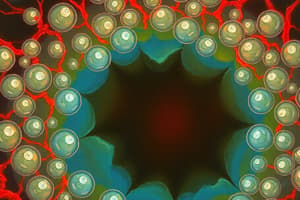Podcast
Questions and Answers
What is the main function of the Golgi apparatus?
What is the main function of the Golgi apparatus?
- To produce energy through cellular respiration
- To degrade old organelles through digestion
- To synthesize ribosomal RNA
- To transport and chemically modify materials (correct)
Which organelle is responsible for the decomposition of hydrogen peroxide?
Which organelle is responsible for the decomposition of hydrogen peroxide?
- Mitochondria
- Lysosomes
- Golgi apparatus
- Peroxisomes (correct)
What structural feature significantly increases the surface area of the inner mitochondrial membrane?
What structural feature significantly increases the surface area of the inner mitochondrial membrane?
- Cisternae
- Cristae (correct)
- Saccules
- Vesicles
What are the small membrane-bound vesicles that contain digestive enzymes called?
What are the small membrane-bound vesicles that contain digestive enzymes called?
Which statement about polyribosomes is true?
Which statement about polyribosomes is true?
What is the primary role of the cytoskeleton within the cytoplasm?
What is the primary role of the cytoskeleton within the cytoplasm?
Which statement correctly describes the difference between Rough ER and Smooth ER?
Which statement correctly describes the difference between Rough ER and Smooth ER?
What is the composition of the cytosol in terms of water percentage?
What is the composition of the cytosol in terms of water percentage?
What type of molecules are primarily involved in the colloidal solutions found in the cytoplasm?
What type of molecules are primarily involved in the colloidal solutions found in the cytoplasm?
Which of the following functions is associated with the rough endoplasmic reticulum?
Which of the following functions is associated with the rough endoplasmic reticulum?
Flashcards
Cytoplasm
Cytoplasm
The region of the cell outside the nucleus, consisting of cytosol and various organelles.
Cytosol
Cytosol
The aqueous component of the cytoplasm, primarily water and dissolved biochemicals.
Endoplasmic Reticulum (ER)
Endoplasmic Reticulum (ER)
Complex network of membranes in the cytoplasm involved in protein and lipid synthesis and transport.
Rough ER
Rough ER
Signup and view all the flashcards
Ribosomes
Ribosomes
Signup and view all the flashcards
Ribosomes
Ribosomes
Signup and view all the flashcards
Golgi Apparatus
Golgi Apparatus
Signup and view all the flashcards
Lysosomes
Lysosomes
Signup and view all the flashcards
Mitochondria
Mitochondria
Signup and view all the flashcards
Cristae of Mitochondria
Cristae of Mitochondria
Signup and view all the flashcards
Study Notes
- Cell ultrastructure and function is the topic of the presentation.
- The cell contents are divided into the nucleus and the cytoplasm, collectively forming the protoplasm.
- The cytoplasm comprises an aqueous cytosol (about 90% water) containing organelles and inclusions.
- The cytoskeleton, a complex network of microfilaments (including actin), provides structural support and is involved in endocytosis/exocytosis and cytoplasmic streaming.
- The endoplasmic reticulum (ER) is a complex system of flattened membrane vesicles (cisternae). It has a tubular and sheet form.
- ER structures include cisternae, vesicles, and tubules.
- There are two types of ER: rough ER (with ribosomes attached, involved in protein synthesis and transport) and smooth ER (without ribosomes, involved in lipid synthesis and detoxification).
- Rough ER is continuous with the nuclear envelope.
- Small vesicles containing newly synthesized proteins pinch off from the rough ER and either fuse with the Golgi apparatus or directly with the cell membrane.
- Smooth ER is also associated with the Golgi apparatus via vesicles.
- Ribosomes are small organelles (20nm in diameter) functioning as protein synthesis sites. They are found in association with rough ER or alone in the cytoplasm and other organelles (e.g., mitochondria, chloroplasts). Ribosomes are composed of two subunits containing RNA and protein.
- Ribosomes can associate to form polyribosomes/polysomes, which appear as whorled patterns on the ER.
- The Golgi apparatus consists of stacks of flattened plate-like cisternae (saccules), sometimes arranged into dictyosomes (especially in plants). It transports and chemically modifies proteins, lipids, and carbohydrates.
- Vesicles from the ER fuse with the Golgi apparatus, and the Golgi modifies substances before packaging them into new vesicles that are released. These substances may include digestive enzymes, antibodies, or materials like suberin for cell walls.
- Lysosomes are membrane-bound vesicles (0.2-0.5 µm) containing lytic enzymes, involved in digesting old organelles, whole cells, and materials brought into the cell via phagocytosis. Lysosomes may be primary or secondary, formed by the Golgi apparatus or by fusion with other vesicles.
- Peroxisomes also contain enzymes, including catalase, for decomposing hydrogen peroxide.
- Mitochondria are small, elongated organelles (2-5 µm) found in eukaryotic cells. Function in aerobic cellular respiration, producing ATP from ADP and phosphate. They have a double membrane system (outer and inner) with an intermembrane space and a folded inner membrane (cristae).
- The mitochondrial matrix holds enzymes of the Krebs cycle, producing reduced NAD and FAD. The cristae provide a large surface area for ATP synthase, involved in ATP production.
- Chloroplasts are plant organelles involved in photosynthesis. They have a double membrane with thylakoid membranes arranged in stacks called grana.
- The stroma is the fluid-filled space in the chloroplast which contains enzymes for the Calvin cycle.
- The thylakoid space is where light-dependent reactions occur, producing ATP and NADPH.
- Vacuoles are large, fluid-filled sacs primarily found in plant cells. They store water, salts, sugars, and pigments.
- Plasmodesmata are channels in cell walls that connect adjacent plant cells, allowing cytoplasmic connections.
- Cell walls provide structural support and rigidity to plant cells. Cell walls are composed of cellulose and a middle lamella.
- Microtubules are part of the cytoskeleton.
- Microvilli are microscopic projections that increase surface area for absorption in some cells. Cell junctions (desmosomes, gap junctions, tight junctions) connect adjacent cells.
- Heterochromatin and euchromatin are different forms of chromatin, the material inside the cell nucleus, differing in condensed structure.
Studying That Suits You
Use AI to generate personalized quizzes and flashcards to suit your learning preferences.




